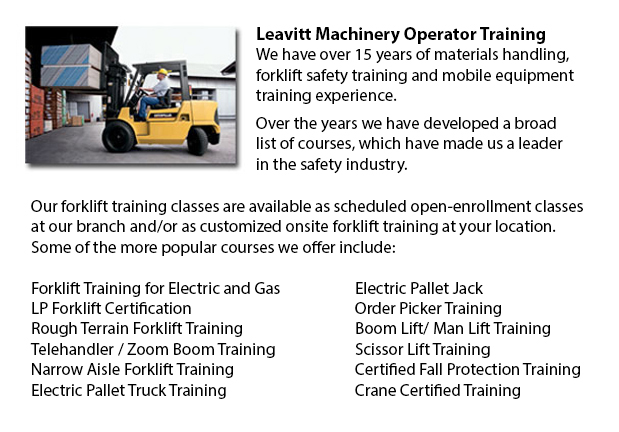
Hyster Forklift Training Oshawa - Hyster is an industry leader in the materials handling industry that has been in business for over 80 years. However, it started as a manufacturer of lifting machines and winches. Most of its production was focused in the Pacific Northwest and dealt primarily with the wood and logging industry. A couple years after the first forklift trucks were invented Hyster became synonymous with quality production. Over the previous eighty years Hyster has continued to get bigger and develop its product line. The growth of its products coupled with its desire to stay service oriented has allowed Hyster to develop into the international participant it is in the present day.
Hyster experienced major innovations through the 1940's and 1960's. In 1946, Hyster opened a plant in Danville, Illinois that was totally devoted to mass manufacturing trucks. This allowed Hyster to drive its costs down and, simultaneously, offer a better quality product at industry competitive rates. In 1952, Hyster began its first foray in to the international production market through opening its first plant in the Netherlands. The Netherlands plant was originally designed to produce two products: Hyster 40" and the Karry Kranes.
Hyster, along with the whole forklift industry, continued to expand into different product lines throughout the 1950's and 60's. They began constructing container handlers in the US in 1959 to meet with the ever growing demand for transportation goods. In 1966, Hyster developed a system for enabling a lift truck to go both ahead and backwards using the same pedal. This pedal was known as the Monotrol pedal, which revolutionized the industry. Later in the decade Hyster opened a R and D centre in Oregon that was focused on improving the design and performance of lift trucks. The centre is still one of the world's top testing facilities in the materials handling industry.
The 60's was characterized by rapid growth throughout the whole materials handling industry. Due to this, Hyster needed to refocus its strategy towards these developing mass markets. Consequently, in 1970, the XL design philosophy was born. The XL design philosophy allowed Hyster to provide greater quality at a more inexpensive cost. A further expansion in manufacturing capabilities was necessitated by the need in Europe for Internal Combustion Engine Vehicles. To plug this gap, a plant in Craigavon, Ireland was opened in 1980. Through the eighties Hyster continued to focus on developing industry leading forklifts. The Hyster company name was recognized throughout the world for its dedication towards excellence. This attention to quality produced a lot of suitors for the enterprise. In 1989, a large international corporation based in Ohio called NACCO Industries purchased Hyster and started an aggressive expansion strategy. NACCO quickly changed the XL philosophy with a more driver oriented truck that concentrated on operator comfort, which is known as the XM generation of forklifts.
The changing needs of Hyster's consumers, led by improvements in supply chain management, required Hyster to continuously innovate and make investments in modern production technology during the next few decades. Acquisitions and investments were made in the US, Italy, Netherlands, and many other places throughout the world. All of these investments have made Hyster a worldwide leader in the forklift market. In 2009, Hyster celebrated its 80th anniversary as an industry leader of materials handling equipment, which comprises over 300 different versions of forklift trucks.
-
Doosan Forklift
Doosan Forklift Training Oshawa - Doosan Infracore Company Ltd. is an international and intercontinental company that features Defense Industry Products, Industrial Vehicles, Diesel Engines, Automation Systems, Machine Tools and Construction Equipme... More -
Rough Terrain Forklifts
Rough Terrain Forklifts Training Oshawa - There are in reality two categories of forklifts within the production industry, the rough terrain model and the industrial version. Rough terrain lift trucks appeared in the 1940's intended predominantly for... More -
Nissan Forklift
Nissan Forklift Training Oshawa - Nissan prides itself on reaching overall customer fulfillment when their buyer is enjoying one of their numerous trucks, cars or forklifts. Nissan Forklift branch is a wholly owned subsidiary of Nissan Motor Co. Ltd.... More -
Aerial Lifts
Aerial Lift Training Oshawa - Aerial lift trucks can be used to accomplish several unique duties performed in hard to reach aerial places. Many of the odd jobs associated with this kind of lift include performing regular maintenance on structures wit... More -
Pallet Lifts
Pallet Lifts Training Oshawa - A pallet haul is equipment designed principally for moving pallets of differing weights and sizes. They may be used in conjunction with cranes, forklifts and other heavy duty machines as an appendage piece or to be util... More

Forklift Certification Oshawa
TOLL FREE: 1-888-254-6157
Oshawa, Ontario
forkliftcertificationoshawa.com
Email Us
About Us


